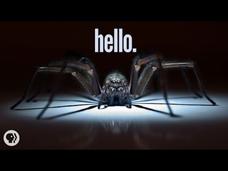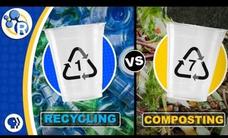TED-Ed
Why We Love Repetition in Music
Why does music rely so heavily on repetition? This is an interesting video from which to explore not only the psychological answers to this question, but also the ways in which humans perceive and rate different types of music.
PBS
Math with Jake: Ratios and Fractions
And the beat goes on. The installment of the Math at the Core: Ratios series introduces time signatures in music. A musician shows the relationship between different types of musical beats. Working in pairs, classmates create beat...
Flocabulary
The 5 Types of Text Structure
Developing an informational text is like designing a building—if the structure is weak, it will not stand. A language arts video provides an overview of the five types of text structure. A catchy song and specific examples help give a...
Rockin' English Lessons
The Weather Song
Get an animated view of what sun, snow, wind, and rain look like in a hand-drawn music video about weather. Elementary learners also explore the words hot and and how these terms relate to our weather.
Be Smart
Why I'm Scared of Spiders
Eighty-four percent of people have an irrational fear. This video focuses on a fear of spiders. It explains the different types of fear, the conditioning that creates fear, and the evolutionary advantage to these fears. It doesn't just...
MinutePhysics
How Modern Light Bulbs Work
Here is a fascinating find for future techies: a video about how various light bulbs work. Because it begins with the incandescent bulb, it covers a bit of history of the light bulbs. It concisely and creatively describes how halogen...
MinutePhysics
What is a Dimension? In 3D...and 2D...and 1D
How many dimensions are there? Latitude, longitude, and altitude are accepted dimensions, but what about time or another type of dimension? An engaging video describes how we theorize that we live in three dimensions and which laws of...
Learning Upgrade
Verbs 1 Song
Sing along with a short, animated video that defines, provides examples of different types of verbs, and models how they operate in a sentence.
American Chemical Society
What Makes Rubber Rubbery?
Surprise! A pigskin isn't actually made from pig skin. Scholars learn about the properties and uses of both natural and synthetic rubber by watching a video in the ACS Reactions series. In particular, the video focuses on the different...
Amoeba Sisters
Bacteria: The Good, The Bad, The Kinda Gross
While the bad bacteria get most of our attention and research into antibiotics, the good bacteria is also important to your health. Explain the different types of bacteria with an illustrative video.
Flocabulary
What Are Pronouns?
Once upon a time, SchoolHouse Rock used Rufus Xavier Sarsparilla to teach a lesson pronouns. Featuring an updated song, the third of four videos in a Language Arts playlist, uses a catchy hip-hop tune to teach about pronoun-antecedent...
American Chemical Society
Chameleons Are Masters of Nanotechnology
The oddball reptiles, chameleons, can teach animal lovers a little something about nanotechnology. Viewers peel away the layers of the chameleon skin to discover the different types of chromatophores using an episode of a larger series...
Curated OER
Enzymes, Proteins, Carbohydrates, Digestion
Did you know that different types of food are digested in different parts of the body? Proteins are primarily digested in the stomach, fats in the small intestine, and carbohydrates begin to break down in the mouth. This highly...
American Chemical Society
The Universe in a Cup of Coffee
Connect the chemical aspects of coffee to the world in which we live! Scholars consider the molecules within coffee and how they interact with the environment as they view an episode of the ACS Reaction series. From caffeine as a...
Crash Course
Friction
Why is it easier to move a heavy object once you initially begin? Help your class explore the differences and similarities between static and kinetic friction as they view the informative video segment about motion. They learn about each...
American Chemical Society
Can Plastic Be Composted?
Some plastics market as green, but are they really? Turns out, the question is a complicated one. A video lesson describes how these new plastics may have some decomposing properties but need a little boost from industry. The lesson...
American Chemical Society
How Milk Becomes Cheese
That sour milk in your fridge is a long way from becoming cheese...or is it? The original purpose of making cheese was simply to preserve the nutritional content of milk. Using an informative video from a larger playlist exploring...
American Chemical Society
How Does Chemotherapy Treat Breast Cancer?
Cancer treatments sure have changed over the years. A short video focuses on current and historical treatments for breast cancer. It covers surgery, chemotherapy, radiation, targeted therapies, and hormone therapies.
Crash Course
The Birth of Off Broadway: Crash Course Theater #47
Many Broadway shows, including Hamilton, got their start off the infamous street. Video 47 from the Crash Course Drama and Theater playlist focuses on the creation of Off-Broadway theater. Discussion centers around specific theaters and...
SciShow
Electromagnetism - Magnetic Force: The Four Fundamental Forces of Physics #4b
The magnets on a refrigerator are stronger than Earth's magnetic force. Watch a video that describes the fundamental force of magnetism. It relates magnetism to electricity and connects this to almost every type of electricity generator...
Teacher's Pet
Changes of States of Matter
While scientists debate if there are five or seven different states of matter, this video introduces the most common three. It explains the properties of each, kinetic theory, and the changes that occur due to temperature fluctuation.
MinuteEarth
This Is Not A Bee
Is it a bee or not a bee? That seems to be the question of a video lesson that explains how insects such as flies and moths mimic the coloring of bees. The narrator discusses the purpose of the coloring in association to predators.
American Chemical Society
The World's Smallest Robots: Rise of the Nanomachines
Think robots are big, clunky heaps of metal? Not anymore! Introduce your class to a whole new breed of robots through a video from the American Chemical Society's Reactions playlist. The resource shows what these tiny machines are made...
PBS
Pitch and Frequency | UNC-TV Science
Musicians and physicists unite for an activity that explains frequency using the guitar as an example. Scientists view an animated video defining frequency and explore pitch changes. During the activity, tension changes on guitar strings...

























